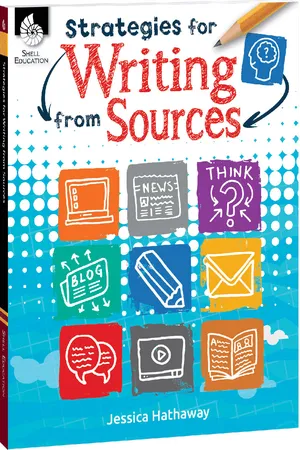
This is a test
- English
- PDF
- Only available on web
eBook - PDF
Strategies for Writing from Sources ebook
Book details
Table of contents
Citations
About This Book
Students in today's classrooms must be able to draw evidence, reasons, and ideas from various sources. This invaluable classroom resource offers practical, easy-to-use strategies to help students analyze any text and use it as a source in their own writing. Sample lessons guide students to use the provided text both as a source for information as well as a mentor text. Each section includes 5 lessons tailored to the specific grade spans, and correlations to state standards for each grade span are also included.
Frequently asked questions
At the moment all of our mobile-responsive ePub books are available to download via the app. Most of our PDFs are also available to download and we're working on making the final remaining ones downloadable now. Learn more here.
Both plans give you full access to the library and all of Perlego’s features. The only differences are the price and subscription period: With the annual plan you’ll save around 30% compared to 12 months on the monthly plan.
We are an online textbook subscription service, where you can get access to an entire online library for less than the price of a single book per month. With over 1 million books across 1000+ topics, we’ve got you covered! Learn more here.
Look out for the read-aloud symbol on your next book to see if you can listen to it. The read-aloud tool reads text aloud for you, highlighting the text as it is being read. You can pause it, speed it up and slow it down. Learn more here.
Yes, you can access Strategies for Writing from Sources ebook by Jessica Hathaway M.S.Ed. in PDF and/or ePUB format, as well as other popular books in Education & Teaching Languages. We have over one million books available in our catalogue for you to explore.
Information
Topic
EducationSubtopic
Teaching LanguagesTable of contents
- Cover
- Credits
- Table of Contents
- Table of Contents Cont.
- Page 5 - Introduction
- Page 5 - Key Shifts in Standards and Instructional Objectives
- Page 6 - Building Critical-Thinking and Comprehension Skills
- Page 10 - Types of Sources
- Page 10 - Reasons for Using Sources
- Page 11 - Evaluating Sources
- Page 12 - Types of Writing
- Page 13 - Strategies for Using Sources in Writing
- Page 17 - Citing Sources and Avoiding Plagiarism
- Page 18 - Writing in the Classroom
- Page 19 - Planning Lessons to Teach Writing from Sources
- Page 20 - How to Use This Book
- Page 22 - Correlation to the Standards
- Page 32 - Strategies for Writing from Sources
- Page 49 - Using Text Sources in Informative Writing
- Page 49 - What Is Informative Writing?
- Page 49 - Informative Writing and Today’s Standards
- Page 50 - The Writing Process for Informative Texts
- Page 51 - The Role of Sources in Informative Writing
- Page 52 - Sample Prompts for Informative Writing
- Page 53 - Bobbing for Apples (K–1)
- Page 61 - Classifying 2-D Shapes (2–3)
- Page 70 - Exploring the New World (4–5)
- Page 79 - Newton’s Laws of Motion (Secondary)
- Page 91 - Using Text Sources in Opinion/Argument Writing
- Page 91 - What Is Opinion/Argument Writing?
- Page 92 - Opinion/Argument Writing and Today’s Standards
- Page 92 - The Writing Process for Opinion/Argument Texts
- Page 93 - The Role of Sources in Opinion/Argument Writing
- Page 94 - Sample Prompts for Opinion/Argument Writing
- Page 95 - Rules (K–1)
- Page 102 - Movie Review (2–3)
- Page 112 - The Benefits of a Shorter School Day (4–5)
- Page 124 - A Letter from Albert Einstein (Secondary)
- Page 137 - Using Text Sources in Narrative Writing
- Page 137 - What Is Narrative Writing?
- Page 138 - Narrative Writing and Today’s Standards
- Page 138 - The Writing Process for Narrative Texts
- Page 140 - The Role of Sources in Narrative Writing
- Page 141 - Sample Prompts for Narrative Writing
- Page 142 - Goal! (K–1)
- Page 150 - Why the Bear Has a Short Tail (2–3)
- Page 158 - The Hound of the Baskervilles (4–5)
- Page 169 - The Red Badge of Courage (Secondary)
- Page 181 - Using Diverse Media Sources in Writing
- Page 181 - What Are Diverse Media Sources?
- Page 181 - Diverse Media Sources and Today’s Standards
- Page 182 - The Writing Process for Using Diverse Media Sources
- Page 185 - Sample Prompts for Writing with Diverse Media Sources
- Page 186 - Bean Porridge (K–1)
- Page 193 - Nature Sounds (2–3)
- Page 202 - Animal Videos (4–5)
- Page 210 - Signing the Civil Rights Act (Secondary)
- Page 219 - Using Multiple Sources in Writing
- Page 219 - How Are Multiple Sources Used in Writing?
- Page 219 - Using Multiple Sources and Today’s Standards
- Page 220 - The Writing Process for Using Multiple Sources
- Page 222 - Sample Prompts for Writing with Multiple Sources
- Page 223 - Jobs Around Town (K–1)
- Page 233 - Healthy Food Choices (2–3)
- Page 243 - Our Wondrous Solar System (4–5)
- Page 257 - The Fight for Freedom (Secondary)
- Page 269 - Appendices
- Page 269 - Appendix A: References Cited
- Page 273 - Appendix B: Answer Key
- Page 287 - Appendix C: Additional Resources
- Page 292 - Appendix D: Contents of the Digital Resource CD
- Thank You Page